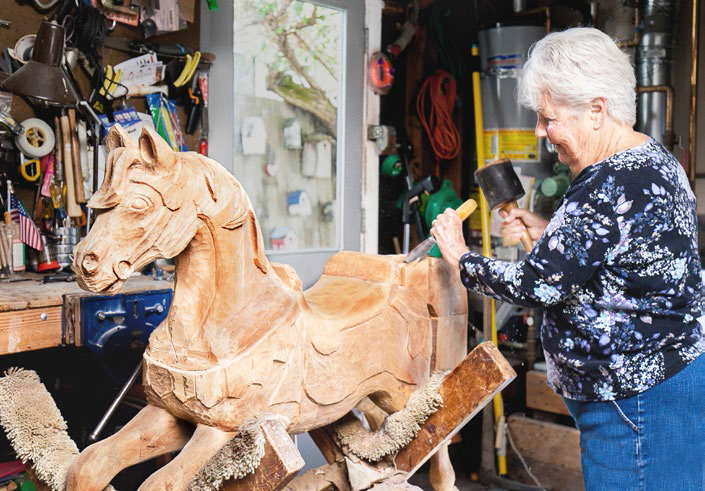Call of the Canopy - Page 3
 |
|
|
 |
|
|
 |
 |
 |
|
|
Some homes have clerestory glass atop, not just exterior walls, but some interior ones as well. "We love that because it lets so much light into the room. It's amazing," Lea Ann Hutter says.
She and James did major reconstruction of their home, which had seen some bad changes. Their work, which aimed to "retain the original feeling of the architecture," she says, added 1,000 square feet to their living area and pushed up the home's height a smidge.
Early Eichler homes like these are beautiful in their simplicity. Joe Nobles, whose living room is filled with chairs and tables of his own design, says the outdoors is "the part I like more than the house." He has installed birdbaths in the backyard to attract wildlife.
"Our dining room table is right near the window," he says. "We just sit there staring at the birds and the squirrels. We don't necessarily watch TV. We just sit there and are totally mesmerized. It's so meditative."
Many homes are surprisingly original both inside and out, including the one Joe shares with his wife, Mariko Hoshi, an animator, whose work you can admire in many films, including various iterations of 'Shrek.'
Eichler used mahogany panels throughout his homes in 1953, not just selected locations, and many owners have retained the warm wood, at least in large part, including Bob Kirchgatter. Marian and Tom Vanden Bosch's home is almost entirely original, and they love it that way.
Ken Harris, a retired cargo supervisor at SFO and a resident since 1964, has original paneling in his home and in an added room from the 1950s. Like many people, he has insulated, and installed a foam roof. He also painted the ceiling white. "It brightens up the place considerably," he says.
Keisha Thoene, "one of the techies that has invaded us," in Marian's good natured words, and her husband Jeff, did much to make their home livable after moving in with an infant seven years ago.
They have lightened up their home's interior, but retained much paneling. "It makes the house a little darker, but we've learned to kind of like it, I think, in our living room," she says.
Of the two homes that show the most exterior changes, one was rebuilt after a 1998 fire that took two lives—those of original residents and founders of the first Lyons Street block parties, Tom and Kay Sullivan.
Christine Bahr, a firefighter, remembers that morning. "I was leaving for work," she says. "If I had just turned around I might have seen something."
At the station she heard the call over the radio. "And I just went, 'Oh my God, that's across the street from me.' I radioed in and said that there were two elderly people who lived there, and the woman was on oxygen."
Neighbors mourned the Sullivans—and later worried about what would replace their Eichler.
"They kept a back wall and the fireplace," Christine says. "We were all concerned. Is it going to be a two-story monster, is it going to be this or that? The guy was really good. He tried to design it like an Eichler."
Many years ago one of their neighbors added a second story to the rear of his home. "From that guy's house you can see into everybody's yard. It overlooks everybody," Roger says.
"The people who live here decided they don't want it," Marian says, of more second-story additions.
There have been no recent threats of two-story homes on the block, and some residents mistakenly believe that city zoning codes would prevent further such depredations. In fact, the zoning is R-1, which allows homes to be up to 28 feet tall and two-and-a-half stories.
It's not surprising that people on Lyons Street like getting to know each other—since so many are worth getting to know. Many are artists—some professional, some not, some quasi—and many are opinionated and talkative, and do interesting, even oddball things.
Take Troy Paiva, for instance, a pioneer in nighttime photography whose photo books and exhibits focus on derelict objects, like F-86 Sabre jets, in derelict places, like a hidden airplane boneyard in the Mojave desert.




